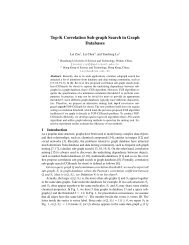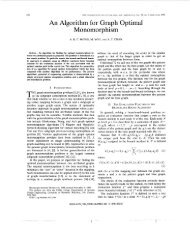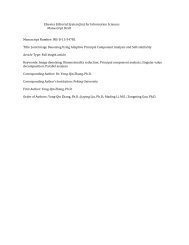GRAIL: Scalable Reachability Index for Large Graphs â - CiteSeerX
GRAIL: Scalable Reachability Index for Large Graphs â - CiteSeerX
GRAIL: Scalable Reachability Index for Large Graphs â - CiteSeerX
Create successful ePaper yourself
Turn your PDF publications into a flip-book with our unique Google optimized e-Paper software.
Construction Time (sec)450400350300250200Constr. TimeQuery Time150012009006003001501002 3 4 5 6 7 8 9 10 0Average Degreeincreasing density. However, note that typically <strong>GRAIL</strong> (with d =5) is an order of magnitude faster than pure DFS in query time.Also <strong>GRAIL</strong> can handle dense graphs, where other methods fail; infact, one can increase the dimensionality to handle denser graphs.5. CONCLUSIONWe proposed <strong>GRAIL</strong>, a very simple indexing scheme, <strong>for</strong> fastand scalable reachability testing in very large graphs, based on randomizedmultiple interval labeling. <strong>GRAIL</strong> has linear constructiontime and index size, and its query time ranges from constant tolinear time per query. Based on an extensive set of experiments,we conclude that <strong>for</strong> the class of smaller graphs (both dense andsparse), while more sophisticated methods give a better query timeper<strong>for</strong>mance, a simple DFS search is often good enough, with theadded advantage of having no construction time or index size overhead.On the other hand, <strong>GRAIL</strong> outper<strong>for</strong>ms all existing methods,as well as pure DFS search, on large real graphs; in fact, <strong>for</strong> theselarge graphs existing indexing methods are simply not able to scale.In <strong>GRAIL</strong>, we have mainly exploited a randomized traversalstrategy to obtain the interval labelings. We plan to explore other labelingstrategies in the future. In general, the problem of finding thenext traversal that eliminates the maximum number of exceptionsis open. The question whether there exists an interval labeling withd dimensions that has no exceptions, is likely to be NP-complete.Thus it is also of interest to obtain a bound on the number of dimensionsrequired to fully index a graph without exceptions. In thefuture, we also plan to generalize <strong>GRAIL</strong> to dynamic graphs.6. REFERENCES[1] R. Agrawal, A. Borgida, and H. V. Jagadish. Efficientmanagement of transitive relationships in large data andknowledge bases. SIGMOD Rec., 18(2):253–262, 1989.[2] P. Bouros, S. Skiadopoulos, T. Dalamagas, D. Sacharidis,and T. Sellis. Evaluating reachability queries over pathcollections. In SSDBM, page 416, 2009.[3] R. Bramandia, B. Choi, and W. K. Ng. On incrementalmaintenance of 2-hop labeling of graphs. In WWW, 2008.[4] Y. Chen. General spanning trees and reachability queryevaluation. In Canadian Conference on Computer Scienceand Software Engineering, Montreal, Quebec, Canada, 2009.[5] Y. Chen and Y. Chen. An efficient algorithm <strong>for</strong> answeringgraph reachability queries. In ICDE, 2008.[6] J. Cheng, J. X. Yu, X. Lin, H. Wang, and P. S. Yu. Fastcomputing reachability labelings <strong>for</strong> large graphs with highcompression rate. In EBDT, 2008.[7] E. Cohen, E. Halperin, H. Kaplan, and U. Zwick.<strong>Reachability</strong> and distance queries via 2-hop labels. SIAM(a)Query Time (sec)2.0521.951.91.85Figure 5: Increasing Graph Density: (a) <strong>GRAIL</strong>, (b) DFSConstruction Time (sec)Constr. TimeQuery Time200001600012000800040001.81.752 3 4 5 6 7 8 9 0Average Degree(b)Journal of Computing, 32(5):1335–1355, 2003.[8] T. H. Cormen, C. E. Leiserson, R. L. Rivest, and C. Stein.Introduction to Algorithms. MIT Press, 2001.[9] C. Demetrescu and G. Italiano. Fully Dynamic TransitiveClosure: Breaking through the O(n 2 ) Barrier. In FOCS,2000.[10] C. Demetrescu and G. Italiano. Dynamic shortest paths andtransitive closure: Algorithmic techniques and datastructures. Journal of Discrete Algorithms, 4(3):353–383,2006.[11] P. F. Dietz. Maintaining order in a linked list. In STOC, 1982.[12] H. He, H. Wang, J. Yang, and P. S. Yu. Compact reachabilitylabeling <strong>for</strong> graph-structured data. In CIKM, 2005.[13] H. V. Jagadish. A compression technique to materializetransitive closure. ACM Trans. Database Syst.,15(4):558–598, 1990.[14] R. Jin, Y. Xiang, N. Ruan, and D. Fuhry. 3-hop: ahigh-compression indexing scheme <strong>for</strong> reachability query. InSIGMOD, 2009.[15] R. Jin, Y. Xiang, N. Ruan, and H. Wang. Efficient answeringreachability queries on very large directed graphs. InSIGMOD, 2008.[16] V. King and G. Sagert. A fully dynamic algorithm <strong>for</strong>maintaining the transitive closure. J. Comput. Syst. Sci.,65(1):150–167, 2002.[17] I. Krommidas and C. Zaroliagis. An experimental study ofalgorithms <strong>for</strong> fully dynamic transitive closure. Journal ofExperimental Algorithmics, 12:16, 2008.[18] L. Roditty and U. Zwick. A fully dynamic reachabilityalgorithm <strong>for</strong> directed graphs with an almost linear updatetime. In STOC, 2004.[19] R. Schenkel, A. Theobald, and G. Weikum. HOPI: anefficient connection index <strong>for</strong> complex XML documentcollections. In EBDT, 2004.[20] R. Schenkel, A. Theobald, and G. Weikum. Efficient creationand incremental maintenance of the hopi index <strong>for</strong> complexxml document collections. In ICDE, 2005.[21] S. Trissl and U. Leser. Fast and practical indexing andquerying of very large graphs. In SIGMOD, 2007.[22] H. Wang, H. He, J. Yang, P. Yu, and J. X. Yu. Dual labeling:Answering graph reachability queries in constant time. InICDE, 2006.[23] J. X. Yu, X. Lin, H. Wang, P. S. Yu, and J. Cheng. Fastcomputation of reachability labeling <strong>for</strong> large graphs. InEBDT, 2006.Query Time (sec)












